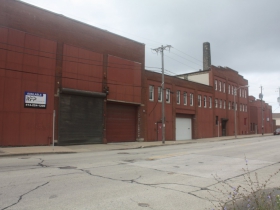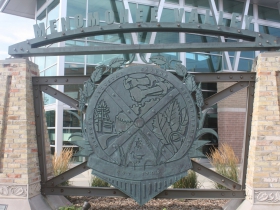The Curious History of St. Paul Avenue
It was once Detroit and Fowler Streets, and before that was under water.

The former Broadway Produce Building is located at E. St Paul Ave. and Broadway. Photo by Carl Baehr.
St. Paul Avenue was once called Detroit Street east of the Milwaukee River, and Fowler Street west of the river. It used to be located in marshy land that was sometimes under water. During the first decades of the city’s history, the streets were filled in to bring them above water level.
Early maps of the city show that Fowler Street ran west from the river to N. 6th Street, where a bluff blocked its progress. The street picked up again on the other side of the hill at N. 8th Street and continued westerly along the floor of the Menomonee River Valley. Fowler Street was the namesake of Albert Fowler, who claimed to be the second white man (after Solomon Juneau) to settle in the city when he arrived in 1833. While Fowler, a Massachusetts native, was only second on the white man list, he was number one on many other lists: Milwaukee’s first post office clerk, first court clerk, first register of deeds, first justice of the peace, and the first to purchase land in the city. Nineteen years after arriving in Milwaukee, he left for Rockford, Illinois, where he served three terms as mayor before dying there in 1883 at the age of seventy.
In 1889, the portion of Fowler Street west of N. 8th Street was renamed St. Paul Avenue. The street was named for the Chicago, Milwaukee, St. Paul and Pacific Railroad, whose tracks and freight yards ran alongside it. The company was a major employer in the city for many decades and was at one time referred to as the St. Paul Road. It started as the Milwaukee and Waukesha Railroad and had its inaugural run of 20 miles between those cities on February 25, 1851. During the next five decades it added more than 11,000 miles of track, reaching all the way to the Pacific Ocean at Seattle in 1906. The railroad went through many name changes over the years, being most familiarly known as the Milwaukee Road. In 1986, the Milwaukee Road merged with the Soo Line Railroad and ceased to exist under the Milwaukee name.
Detroit Street was named by Juneau and his business partner, Morgan Martin, in 1835. They named east-west streets, in what would become the Third Ward, with a Great Lakes theme. Starting with Wisconsin, the streets were named Michigan, Huron (now Clybourn), Detroit, Buffalo, and Chicago. In 1856 Erie Street was added to the group.
In the mid-1960s, when freeway construction eliminated the gap between Fowler Street and W. St. Paul Avenue, the two block section was paved and the two streets became one. At the same time a bridge was built over the river, connecting W. Fowler and E. Detroit Streets. The city policy by then was that a street could have only one name. St. Paul Avenue was the name chosen, consigning Detroit and Fowler to street name history.
From the bustle of pedestrians in the Third Ward and the activity at the Milwaukee Intermodal Station at N. 5th Street, to the deserted and pedestrian-unfriendly street west of the I-94 underpass, to the residential areas west of N. 27th Street, St. Paul Avenue is a study in contrasts.
In the Third Ward at N. Broadway is the former Broadway Produce building which was placed on National Register of Historic Places and is now home to Cafe Benelux. Across the street, the building occupied by The Wicked Hop is the only remaining structure on E. St. Paul Avenue that was there before the Third Ward Fire of 1892.
Beyond the Intermodal Station and the Marquette Interchange, the street deteriorates into an industrial area with many empty buildings and sidewalks blocked by overgrown vegetation and docked trucks. In one case, a fence closes the sidewalk for no apparent reason and, based on the weeds growing in the sidewalk cracks, it has been there for some time.
A few businesses have attempted to spruce up the street, among them the Brass Light Gallery, with colorful murals on the windows with greenery below them. In front of the Potawatomi building at N. 13th Street is a gateway monument to the Menomonee River Valley that was donated by the Forest County Potawatomi. At N. 19th Street, Sobelman’s Pub & Grill has provided a pleasant place for its outdoor diners.
As St. Paul Avenue climbs out of the Menomonee River Valley it crosses N. 27th Street, and runs through the residential neighborhoods of Merrill Park and Piggsville before it stops at the Menomonee River at N. 42nd Street. It goes through two more residential areas as it resumes for four blocks at Hawley Road and then again for four more blocks at N. 91st Street. There it finally ends.
Carl Baehr, a Milwaukee native, is the author of Milwaukee Streets: the Stories Behind their Names, and articles on local history topics. He has done extensive research on the sinking of the steamship Lady Elgin, the Newhall House Fire, and the Third Ward Fire for his upcoming book, “Dreams and Disasters: A History of the Irish in Milwaukee.” Baehr, a professional genealogist and historical researcher, gives talks on these subjects and on researching Catholic sacramental records. He earned an MLIS from the UW-Milwaukee School of Information Studies.
Sites Along St. Paul Avenue
City Streets
-
The Curious History of Cathedral Square
 Sep 7th, 2021 by Carl Baehr
Sep 7th, 2021 by Carl Baehr
-
Gordon Place is Rich with Milwaukee History
 May 25th, 2021 by Carl Baehr
May 25th, 2021 by Carl Baehr
-
11 Short Streets With Curious Names
 Nov 17th, 2020 by Carl Baehr
Nov 17th, 2020 by Carl Baehr




























Very interesting article. However, with all due respect, I would re-visit the area west of the I-94 underpass claimed to be “deserted and pedestrian-unfriendly”. I’ve worked in this area for some time, and I find it to be neither of those things.
A precursory drive may make it seem so, but spending actual time on foot exploring the area would prove otherwise. Like many neighborhoods of Milwaukee before they became trendy, there’s more than meets the eye.
Sloane, I am glad you found the article interesting.
I did not drive on the street at all. I walked it three times before writing the article. During those walks I did not pass any other pedestrians. I had to leave the sidewalk on several occasions because it was blocked, as the photos show. I walk all the the streets that I write about and have not run into any sidewalks blocked with vegetation or old fences. To me, that section of the street is deserted and very pedestrian unfriendly.
I care for Milwaukee very much and I hope these obstructions are cleared up and that this section of St. Paul Avenue does become trendy, but I can only see what meets my eye.
This article explains why I remember Milwaukee having a train station on “Fowler”.
One other notable thing about St. Paul Ave. … It includes the first street section rebuilt for the new streetcar. The bridge and the roadway right next to the bridge have gaps (temporarily filled with another material) to accommodate the rails. You can see this in this article’s “Picture 11”. You can see where the eastbound rail will go (in the left EB traffic lane). The photo doesn’t show the WB rails (in the WB right traffic lane), but you can see it if you walk across the bridge.
@Tom D Good point on the bridge
Another excellent article on Milwaukee streets. It would be nice if these articles could be archived and easily retrievable on Urban Milwaukee’s website.
The building at 1100 E Kane Place, the northeast corner of Humboldt and Kane) was once located at the corner of Detroit and Van Buren. It was moved to the current location in 1907.
Thanks for this, Carl. Two points on the ‘original’ St. Paul Avenue: while the street once ended at Eighth Street, a later extension brought St. Paul as far east as Sixth, at Clybourn Street, where this odd-angled street added to an intersection already jammed with car, truck, streetcar and North Shore interurban traffic.
And while this is probably outside your remit, a history of St. Pail Avenue ought to acknowledge “Dirty Helen’ Cromell, who for thirty-five years dispensed booze and profanity in equal portions at the Sunflower Inn, 1806 West St. Paul (now an empty lot.)
Before the construction of the post office/Union Station complex in 1965, Fowler Street was an odd, isolated industrial area, much like Walker’s Point across the river/ It was lined with cold-storage warehouses and loft buildings (including a few remnants of the Palmolive Soap Co. once headquartered at Second and Fowler), busy by day but deserted at night except, at the corner of Plankinton Avenue, an early gay bar, Tony’s Riviera.
Most of this was lost in the mid-sixties; soon after the post office and station came the epic-scale devastation of the interstate highway. Thanks again for reminding us of a bit of old Milwaukee.